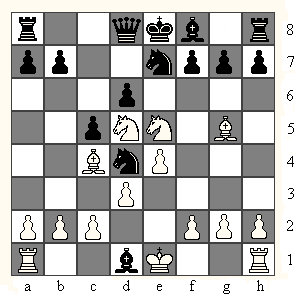Colin James Physics - Logic puzzles.

Last updated: 25th June 2013.
Logic puzzles.
These are general logic puzzles - not Physics puzzles, but they should be challenging and fun (just like Physics).
If you know what you are looking for in a puzzle or have done a similar one before you may find an easier puzzle harder or a harder one straightforward.
So it its worth scanning through the different categories.
When you click on a puzzle it will appear below (and the screen will move down to show the puzzle) with a solution further down the screen.
Easier puzzles.
Running puzzle.
Tennis puzzle.
Water puzzle.
Walking puzzle.
Harder puzzles.
Spending puzzle.
Cakes puzzle.
Ages puzzle.
Chess puzzles.

Chess puzzle 1.
Chess puzzle 2.
Chess puzzle 3.
Chess puzzle 4.
Chess puzzle 5.
Spending puzzle.

I start off with a certain amount of money.
I visit five shops and at each shop I spend half the money I have with me when I enter the shop plus an extra ten pounds.
After visiting the last shop I have no money left.
How much money did I have when I started?
Solution

Solution

Solution

Solution

Solution 1 (The Easy Way): Spending puzzle.

Original amount of money = 620 pounds.
I have given detailed solutions below but you can simplify the calculation, for example by working backwards from the last shop step by step:
As I enter the last shop I have x pounds. I spend (x/2 + 10) pounds.
After I leave the last shop I have zero pounds = x - (x/2 + 10) pounds {what I had when I went in minus what I spent}.
Therefore: x - (x/2 + 10) = 0
x - x/2 - 10 = 0
x/2 - 10 = 0
x/2 = 10
x = 20
and so on until you are in the position of entering the first shop.
Solution 2 - Using recurrence relations.
Variables.
a0 = original amount of money.
a1 = amount of money left after spending in shop 1.
a2 = amount of money left after spending in shop 2.
a3 = amount of money left after spending in shop 3.
a4 = amount of money left after spending in shop 4.
a5 = amount of money left after spending in shop 5.
|
s1 = amount of money spent in shop 1.
s2 = amount of money spent in shop 2.
s3 = amount of money spent in shop 3.
s4 = amount of money spent in shop 4.
s5 = amount of money spent in shop 5.
|
Recurrence relations.
s1 = 1/2 a0 + 10
a1 = a0 - s1
s2 = 1/2 a1 + 10
a2 = a1 - s2
s3 = 1/2 a2 + 10
a3 = a2 - s3
s4 = 1/2 a3 + 10
a4 = a3 - s4
s5 = 1/2 a4 + 10
a5 = a4 - s5
General relations for a number r, where r Î {1, 2, 3, 4, 5}
sr = 1/2 ar-1 + 10 ----- (A)
ar = ar-1 - sr ----- (B)
Substituting (B) in (A) gives:
ar = ar-1 - (1/2 ar-1 + 10)
ar = ar-1 - 1/2 ar-1 - 10
ar = 1/2 ar-1 - 10 ----- (C)
Strategy.
We need to find a0 = original amount of money.
We can solve the recurrence relations with the initial condition a5 = 0 as a5 = amount of money left after
spending in shop 5 and there is no money left after the 5th shop.
So we can find a5 in terms of a0 and equate the expression for a5 to zero, then
solve for a0.
Solution 2 (Working forwards in time using recurrence relations):Spending puzzle.
a5 = a4 - s5
a5 = a4 - (1/2 a4 + 10)
a5 = 1/2 a4 - 10
a5 = 1/2 (a3 - s4) - 10
a5 = 1/2 (a3 - (1/2 a3 + 10)) - 10
a5 = 1/2 (1/2 a3 - 10) - 10
a5 = 1/2 (1/2 (a2 - s3) - 10) - 10
a5 = 1/2 (1/2 (a2 - (1/2 a2 + 10)) - 10) - 10
a5 = 1/2 (1/2 (1/2 a2 - 10) - 10) - 10
a5 = 1/2 (1/2 (1/2 (a1 - s2) - 10) - 10) - 10
a5 = 1/2 (1/2 (1/2 (a1 - (1/2 a1 + 10)) - 10) - 10) - 10
a5 = 1/2 (1/2 (1/2 (1/2 a1 - 10) - 10) - 10) - 10
a5 = 1/2 (1/2 (1/2 (1/2 (a0 - s1) - 10) - 10) - 10) - 10
a5 = 1/2 (1/2 (1/2 (1/2 (a0 - (1/2 a0 + 10)) - 10) - 10) - 10) - 10
a5 = 1/2 (1/2 (1/2 (1/2 (1/2 a0 - 10) - 10) - 10) - 10) - 10
Setting a5 = 0 gives:
1/2 (1/2 (1/2 (1/2 (1/2 a0 - 10) - 10) - 10) - 10) - 10 = 0
1/2 (1/2 (1/2 (1/2 (1/2 a0 - 10) - 10) - 10) - 10) = 10
1/2 (1/2 (1/2 (1/2 a0 - 10) - 10) - 10) - 10 = 20
1/2 (1/2 (1/2 (1/2 a0 - 10) - 10) - 10) = 30
1/2 (1/2 (1/2 a0 - 10) - 10) - 10 = 60
1/2 (1/2 (1/2 a0 - 10) - 10) = 70
1/2 (1/2 a0 - 10) = 150
1/2 a0 - 10 = 300
1/2 a0 = 310
a0 = 620
Solution 3 (Working backwards in time using recurrence relations): Spending puzzle.
Working backwards from the last shop to the previous shop, to the shop before that and so on we need ar-1 in terms of ar.
Using equation (C) above and rearranging:
ar = 1/2 ar-1 - 10 ----- (C)
ar + 10 = 1/2 ar-1
2ar + 20 = ar-1
ar-1= 2ar + 20
setting r = 5 and using the initial condition a5 = 0:
a4 = 2a5 + 20
a4 = 2 x 0 + 20
a4 = 20
a3= 2a4 + 20
a3= 2 x 20 + 20 = 60
a2= 2a3 + 20
a2= 2 x 60 + 20 = 140
a1= 2a2 + 20
a1= 2 x 140 + 20 = 300
a0= 2a1 + 20
a0= 2 x 300 + 20 = 620
a0= 620
End of page.






